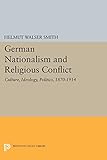German Nationalism and Religious Conflict : Culture, Ideology, Politics, 1870-1914 / Helmut Walser Smith.
Material type: TextSeries: Princeton Legacy Library ; 286Publisher: Princeton, NJ : Princeton University Press, [2014]Copyright date: ©1995Edition: Course BookDescription: 1 online resource (288 p.) : 2 line drawings 1 map 6 tablesContent type:
TextSeries: Princeton Legacy Library ; 286Publisher: Princeton, NJ : Princeton University Press, [2014]Copyright date: ©1995Edition: Course BookDescription: 1 online resource (288 p.) : 2 line drawings 1 map 6 tablesContent type: - 9780691604459
- 9781400863891
- 320.5/4/0943 20
- DD204
- online - DeGruyter
- Issued also in print.
| Item type | Current library | Call number | URL | Status | Notes | Barcode | |
|---|---|---|---|---|---|---|---|
 eBook
eBook
|
Biblioteca "Angelicum" Pont. Univ. S.Tommaso d'Aquino Nuvola online | online - DeGruyter (Browse shelf(Opens below)) | Online access | Not for loan (Accesso limitato) | Accesso per gli utenti autorizzati / Access for authorized users | (dgr)9781400863891 |
Browsing Biblioteca "Angelicum" Pont. Univ. S.Tommaso d'Aquino shelves, Shelving location: Nuvola online Close shelf browser (Hides shelf browser)

|

|

|

|

|

|

|
||
| online - DeGruyter Schumann and His World / | online - DeGruyter Dueling : The Cult of Honor in Fin-de-Siècle Germany / | online - DeGruyter Semitic Words in Egyptian Texts of the New Kingdom and Third Intermediate Period / | online - DeGruyter German Nationalism and Religious Conflict : Culture, Ideology, Politics, 1870-1914 / | online - DeGruyter Milton and the Revolutionary Reader / | online - DeGruyter Julian of Norwich's Showings : From Vision to Book / | online - DeGruyter Thinking Out Loud : An Essay on the Relation between Thought and Language / |
Frontmatter -- Contents -- Figures and Tables -- Acknowledgments -- Notes on Usage and Translation -- Introduction -- PART ONE: CULTURE, IDEOLOGY, SOCIETY -- 1. The Kulturkampf and German National Identity -- 2. Visions of the Nation: The Ideology of Religious Conflict -- 3. Religious Conflict and Social Life -- PART TWO: POLITICS -- 4. The Politics of Nationalism and Religious Conflict, 1897-1906 -- 5. The Politics of Nationalism and Religious Conflict, 1907-14 -- PART THREE: RELIGIOUS AND NATIONALITY CONFLICT IN THE BORDERLANDS OF THE IMAGINED COMMUNITY -- 6. Protestants, Catholics, and Poles: Religious and Nationality Conflicts in the Empire's Ethnically Mixed Areas, 1897-1914 -- 7. Los von Rom: Religious Conflict and the Quest for a Spiritual Pan-Germany -- Conclusion -- Sources -- Index
restricted access online access with authorization star
http://purl.org/coar/access_right/c_16ec
The German Empire of 1871, although unified politically, remained deeply divided along religious lines. In German Nationalism and Religious Conflict, Helmut Walser Smith offers the first social, cultural, and political history of this division. He argues that Protestants and Catholics lived in different worlds, separated by an "invisible boundary" of culture, defined as a community of meaning.As these worlds came into contact, they also came into conflict. Smith explores the local as well as the national dimensions of this conflict, illuminating for the first time the history of the Protestant League as well as the dilemmas involved in Catholic integration into a national culture defined primarily by Protestantism.The author places religious conflict within the wider context of nation-building and nationalism. The ongoing conflict, conditioned by a long history of mutual intolerance, was an integral part of the jagged and complex process by which Germany became a modern, secular, increasingly integrated nation. Consequently, religious conflict also influenced the construction of German national identity and the expression of German nationalism. Smith contends that in this religiously divided society, German nationalism did not simply smooth over tensions between two religious groups, but rather provided them with a new vocabulary for articulating their differences. Nationalism, therefore, served as much to divide as to unite German society.Originally published in 1995.The Princeton Legacy Library uses the latest print-on-demand technology to again make available previously out-of-print books from the distinguished backlist of Princeton University Press. These editions preserve the original texts of these important books while presenting them in durable paperback and hardcover editions. The goal of the Princeton Legacy Library is to vastly increase access to the rich scholarly heritage found in the thousands of books published by Princeton University Press since its founding in 1905.
Issued also in print.
Mode of access: Internet via World Wide Web.
In English.
Description based on online resource; title from PDF title page (publisher's Web site, viewed 30. Aug 2021)


